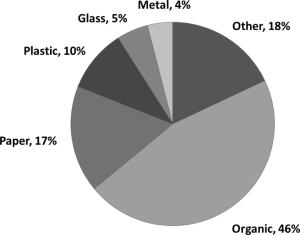Profile
Globally, the largest source of solid waste is organic waste (Figure 1). Recyclable paper and plastic represent more than a quarter of all waste;3 however, a disproportionate quantity of plastic contributes to ocean pollution. Between 60–80% of oceanic pollution is composed of plastic waste,4 which is the primary contributor to the Great Pacific Garbage Patch.5 This garbage patch is a massive ocean area approximately the size of Texas, polluted with partially decomposed plastic from around the world, with devastating effects on marine animals. Sites can have a positive global environmental impact by reducing purchases of Styrofoam™, bottled water, and other disposable plastic products.

Data Source: The World Bank
According to the U.S. Environmental Protection Agency (EPA), in typical office buildings, paper and recyclable paper products account for almost 90% of all waste. Sites can make a substantial net positive impact by providing composting for organic materials, and recycling for paper and plastic, after first implementing resource consumption reduction strategies. For large sites or for sites located in well-developed regions, nearly 100% of the waste stream can be diverted from landfills through careful planning, management, and tracking provided under a comprehensive waste and diversion program.
Considerations
A successful sustainable materials plan encompasses all life-cycle stages of resource consumption, including sustainability-conscious purchasing, resource reuse and reduction, and responsible waste disposal or diversion.
Figure 2: The major stages in a material’s life-cycle

Image Source: U.S. Environmental Protection Agency
All strategies should be incorporated into policy documents for sites operations and renovations, and the policies should be communicated to site personnel. Each site should perform an assessment to determine the composition of its particular waste streams, as well as review current purchasing standards to identify opportunities. Results of these assessments can enable sites to establish a materials-focused plan that includes the elements outlined in each of the individual strategies.
The most effective sequence for managing waste and reducing resource consumption is as follows:
1. Green purchasing: Implement and follow an EPA policy for new purchases. Consider product characteristics such as recycled content, ability to compost, reusability, and non-toxic material content, as well as locally sourced products. The procurement of low-impact products and materials is especially critical for sites where municipal or third-party waste diversion is lacking.
2. Source reduction and reuse: Implement operational strategies to decrease consumption and reduce waste and product purchasing quantities. Source reduction includes reusing products and materials, extending the lifespan of products, and avoiding the downstream impacts of new purchases. Source reduction strategies are most important at sites that lack municipal or third-party waste disposal infrastructure. Sending even low-level hazardous materials, such as AAA batteries, to a landfill can affect the local population, animals, and plants.
3. Disposal management: Once the quantity of generated waste has been reduced, ensure responsible disposal of the remaining waste stream, particularly construction demolition waste and hazardous waste, such as mercury-containing lamps or electronics. Where municipal or third-party recycling systems are available, sites may further increase their waste diversion. Investigate opportunities for on-site and off-site composting.

